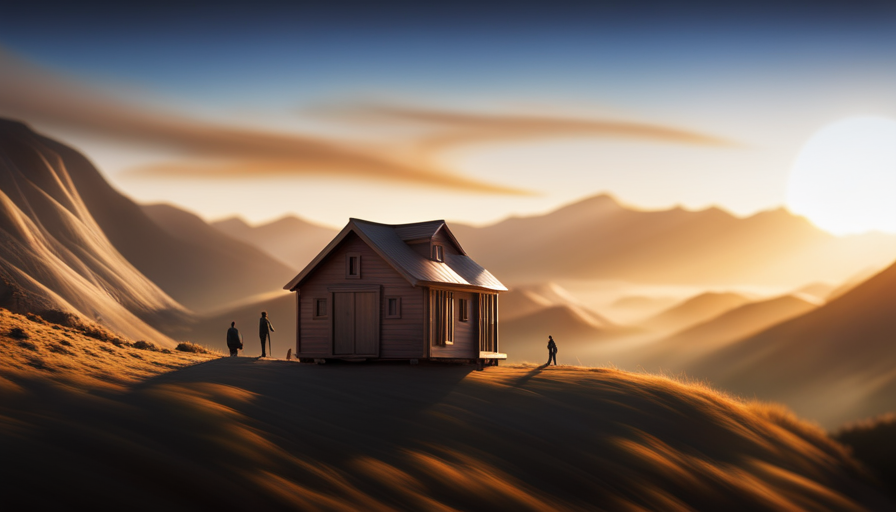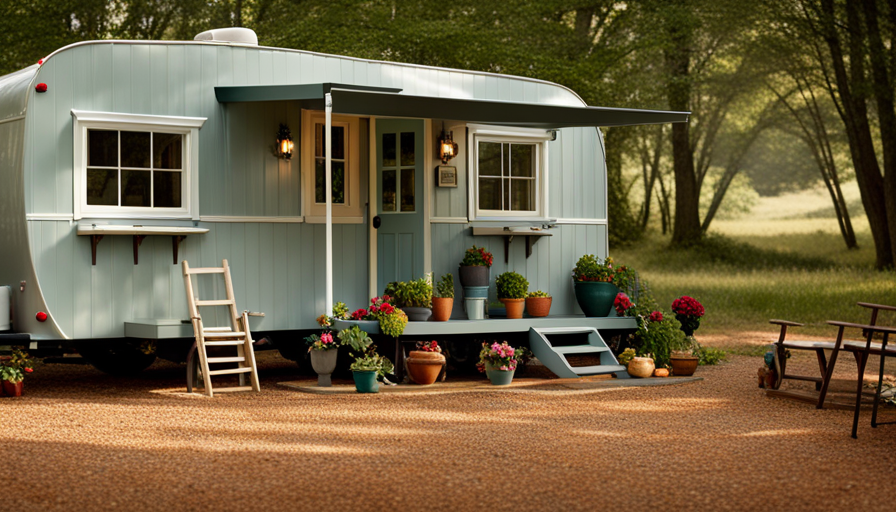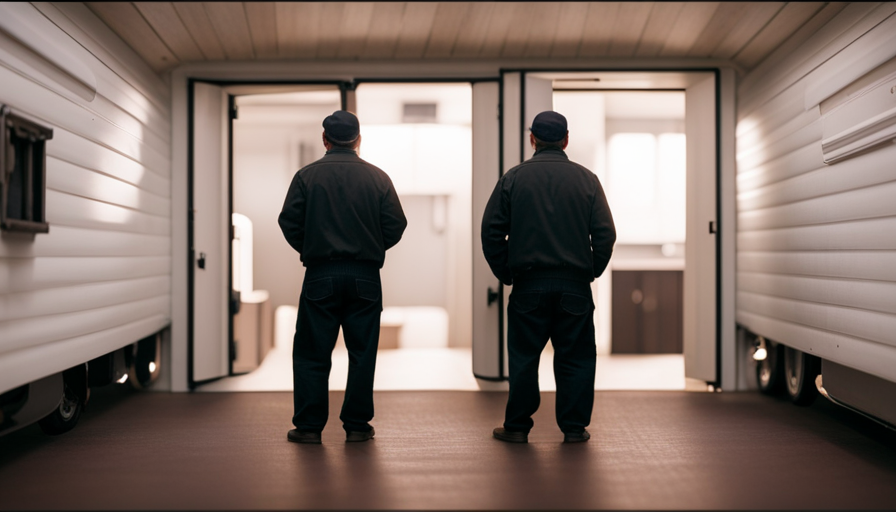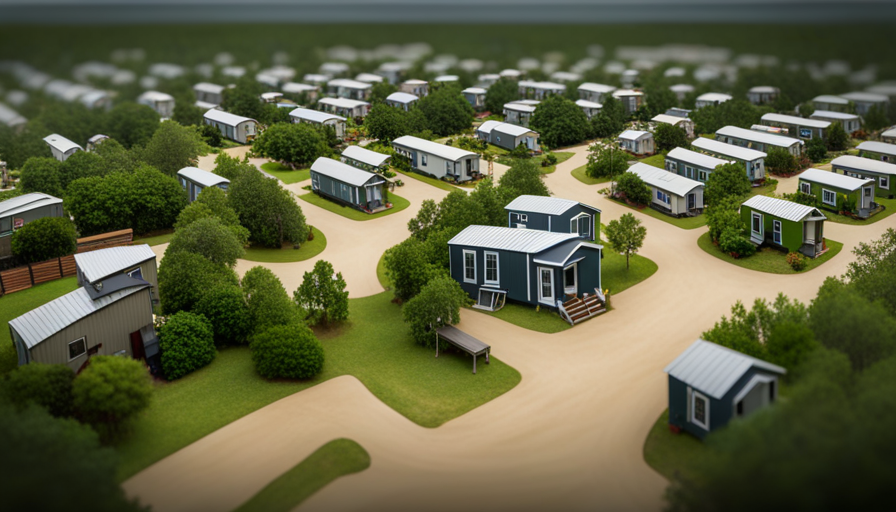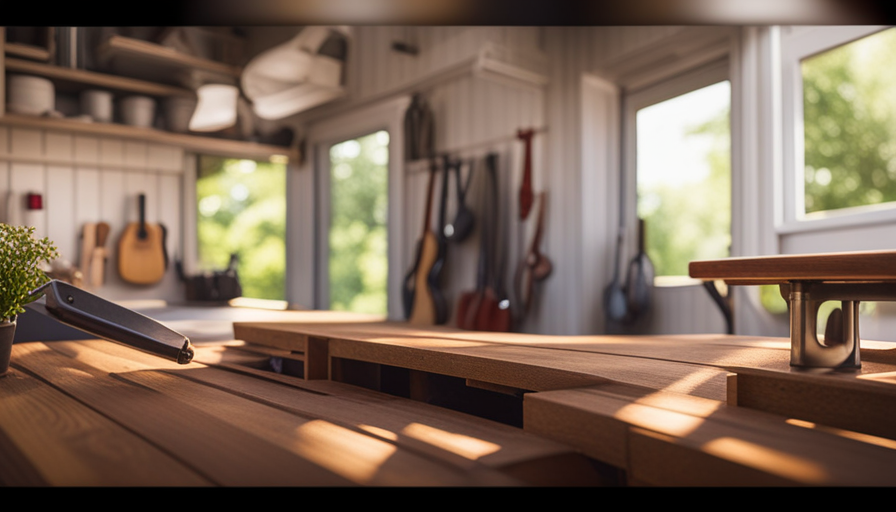Venturing into the world of tiny living has captivated me with the idea of creating a cozy sanctuary that pushes the boundaries of traditional living norms. The juxtaposition of limited space with endless possibilities is both intriguing and inspiring. How far can you push the boundaries of your tiny home? The answer lies in a delicate balance of creativity, practicality, and innovative design tactics.
In this article, we will embark on a journey to explore the different size options available for tiny houses. From compact micro dwellings to slightly larger abodes, we will delve into the world of maximizing space without compromising on comfort. We will also consider your lifestyle and needs, because let’s face it, our tiny house should reflect who we are and how we want to live.
Join me as we seek professional advice and guidance, discovering the secrets to customizing our tiny house to suit our preferences. Together, we will unlock the potential of outdoor living spaces, creating a seamless connection between our cozy interior and the great outdoors.
So, let’s embrace the charm of tiny living and unleash our creativity as we navigate the limitless possibilities of how big we can make our tiny house.
Key Takeaways
- The size of a tiny house depends on imagination, practicality, and clever design solutions.
- Tiny houses can range from compact micro dwellings to slightly larger abodes.
- Lifestyle and needs should be considered when customizing a tiny house.
- Tiny houses offer benefits such as reducing costs, simplifying living, and having a smaller environmental footprint.
Understand the Concept of Tiny Living
So, how big can you make your tiny house? You’ll be amazed at the endless possibilities of creating a cozy and functional living space that perfectly embodies the concept of tiny living.
Living in a tiny house brings numerous benefits, such as reduced costs, simplified living, and a smaller environmental footprint. However, it also comes with its own set of challenges, like limited storage space and the need for creative design solutions. Despite these challenges, the rewards of tiny living are well worth it.
Now, let’s explore different size options for tiny houses, ranging from compact micro homes to slightly larger models that still maintain the essence of minimalistic living.
Explore Different Size Options for Tiny Houses
When it comes to tiny houses, there are a variety of size options to choose from. Starting with micro tiny houses, which are typically less than 100 square feet, these compact dwellings offer a minimalistic lifestyle with just enough space for the essentials.
Moving up to small tiny houses, ranging from 100 to 400 square feet, you can have a bit more room to play with while still embracing the simplicity of tiny living.
Finally, there are mid-sized tiny houses, which can range from 400 to 800 square feet, offering even more space for customization and personalization.
No matter the size, each tiny house option presents its own unique opportunities for creative design and efficient living.
Micro Tiny Houses
Although small in size, micro tiny houses are like cozy little nests that offer all the necessities of comfortable living. These tiny wonders are a part of the micro tiny house movement, which is gaining popularity for its numerous benefits. Here are five reasons why living in a micro tiny house is a smart choice:
-
Efficient use of space: Micro tiny houses utilize every inch of space, ensuring that nothing goes to waste.
-
Lower cost of living: With a smaller footprint, micro tiny houses require less maintenance and have lower utility bills.
-
Minimal environmental impact: These tiny homes consume less energy and produce fewer greenhouse gas emissions, making them eco-friendly.
-
Simplified lifestyle: Living in a micro tiny house encourages a minimalist lifestyle, allowing for more freedom and less clutter.
-
Mobility: Micro tiny houses are often built on wheels, enabling homeowners to travel and explore different locations effortlessly.
Transitioning into the next section about small tiny houses, let’s dive into the possibilities of maximizing space even further.
Small Tiny Houses
With their clever design and ingenious use of space, small tiny houses become cozy havens that feel like a warm embrace. Small tiny house designs prioritize efficiency and functionality, ensuring that every square inch is utilized to its fullest potential.
From loft bedrooms to hidden storage compartments, these homes are a testament to the power of creativity. Living in a small tiny house offers numerous benefits. Not only do they require less maintenance and upkeep, but they also have a smaller carbon footprint, making them an environmentally friendly choice.
Additionally, the smaller size encourages a simpler, more minimalist lifestyle, allowing for a greater sense of freedom and financial flexibility. Transitioning to mid-sized tiny houses, we explore the next level of tiny living without compromising on comfort and functionality.
Mid-Sized Tiny Houses
Embrace the next level of tiny living by exploring mid-sized tiny houses, where comfort and functionality are not compromised. Mid-sized tiny houses offer a perfect balance between spaciousness and simplicity, making them an ideal choice for those who desire a bit more room without sacrificing the benefits of tiny living. These designs are carefully crafted to maximize every square inch, providing ample storage solutions and multipurpose furniture. Cost-effective mid-sized options are available, allowing you to create a comfortable living space without breaking the bank. Consider incorporating loft areas or cleverly designed staircases to optimize vertical space. Additionally, choosing an open floor plan can create a sense of spaciousness and flow. When designing your mid-sized tiny house, it’s important to consider your lifestyle and needs, ensuring that every element of your home serves a purpose and enhances your daily life.
Consider Your Lifestyle and Needs
Imagine customizing your tiny house to perfectly fit your lifestyle and needs, creating a space that’s both functional and visually appealing. When considering the size of your tiny house, it’s important to consider your budget and prioritize functionality. Here are five key factors to consider:
-
Storage Solutions: Incorporate clever storage options like built-in cabinets, hidden compartments, and multi-purpose furniture to maximize space and keep your belongings organized.
-
Flexible Layout: Design your tiny house with a flexible layout that allows for easy rearrangement of furniture and adapts to your changing needs over time.
-
Outdoor Living Space: Create an outdoor living area with a deck or patio to expand your usable space and enjoy the outdoors.
-
Energy Efficiency: Incorporate energy-efficient features like solar panels, LED lighting, and insulation to reduce your environmental impact and save on utility bills.
-
Personal Touches: Add personal touches and unique design elements that reflect your personality and make your tiny house feel like home.
By considering these factors, you can maximize space with clever design solutions that make your tiny house feel spacious and comfortable.
Maximize Space with Clever Design Solutions
When it comes to designing your compact abode, get creative and think outside the box to maximize space with clever design solutions. In a tiny house, storage is key, so it’s important to utilize every inch of space efficiently. One great way to do this is by incorporating clever space-saving furniture. For example, a sofa that can transform into a bed or a coffee table with built-in storage compartments. Another solution is to make use of vertical space by installing shelves or hooks on the walls. Additionally, consider utilizing multi-functional furniture, such as a dining table that can also be used as a workspace. To give you an idea of how to optimize your tiny house, here’s a table showcasing some clever storage solutions:
| Furniture | Function |
|---|---|
| Murphy Bed | Saves space by folding up into the wall |
| Ottoman with Storage | Provides extra seating and hidden storage |
| Drop-Leaf Table | Expands or folds down to save space |
| Staircase with Drawers | Offers storage while serving as a staircase |
By incorporating these clever design solutions, you can create a functional and organized tiny house. Now, let’s explore how to incorporate outdoor living spaces without sacrificing space inside.
Incorporate Outdoor Living Spaces
To fully optimize your compact living space, consider incorporating outdoor living areas to expand your overall square footage. Outdoor spaces can provide additional room for relaxation, entertainment, and even cooking.
Here are three creative ideas to incorporate into your tiny house design:
-
Outdoor Kitchen: Install a compact kitchenette in your outdoor living area, complete with a grill, sink, and countertop space. This will allow you to prepare meals and entertain guests without taking up valuable indoor space.
-
Rooftop Garden: Utilize the top of your tiny house by creating a rooftop garden. This green space can be used for growing herbs, vegetables, or even flowers, providing you with fresh produce and a serene spot to unwind.
-
Lounge Area: Design a cozy lounge area in your outdoor space, with comfortable seating and a small table. This will provide a perfect spot for reading, relaxing, or enjoying a cup of coffee.
By incorporating these outdoor living areas, you can maximize the functionality and enjoyment of your tiny house. Seeking professional advice and guidance can provide valuable insights into designing the perfect outdoor spaces to suit your needs.
Seek Professional Advice and Guidance
By enlisting the assistance of professionals in the field, you can gain invaluable advice and guidance when it comes to maximizing the potential of your compact living space.
Seeking professional assistance is crucial for ensuring that your tiny house meets all the legal requirements and regulations. These experts can help you navigate through the complexities of building codes, zoning laws, and permits, ensuring that your tiny house is compliant and safe.
They can also provide you with valuable insights on design and layout, helping you make the most of every inch of your space. With their expertise, you can create a functional and efficient living environment that suits your needs and preferences.
So, let’s explore how you can customize your tiny house to suit your preferences and make it truly unique.
Customize Your Tiny House to Suit Your Preferences
One way to truly make your compact living space your own is by personalizing every nook and cranny. When it comes to customizing your tiny house, the possibilities are endless.
From the layout and design to the colors and materials, you have the freedom to create a space that reflects your unique style and preferences.
One popular option for customizing your tiny house is to focus on the interior. By incorporating customized interiors, you can maximize the use of space and create a functional yet aesthetically pleasing environment.
Consider investing in space-saving furniture, such as foldable tables and beds with built-in storage. These clever solutions can help you make the most of your limited square footage while still allowing you to express your personal taste and style.
Frequently Asked Questions
What are some common challenges people face when transitioning to tiny living?
Transitioning to tiny living can present some common challenges. One of the main hurdles is the process of downsizing, which can be emotionally and physically demanding. Adjusting to limited space requires creativity and organization to maximize every square inch.
Storage becomes a constant concern, and finding clever solutions becomes a necessity. Additionally, adapting to a simpler lifestyle and letting go of unnecessary possessions can be a psychological challenge. However, with determination and a positive mindset, these challenges can be overcome, and the rewards of tiny living can be truly fulfilling.
Are there any restrictions or regulations on the size of a tiny house?
There are indeed restrictions and regulations on the size of a tiny house. These rules help ensure safety and conformity with local building codes.
While the concept of ‘tiny’ may evoke images of limited space, it is important to understand that these restrictions are in place to maintain structural integrity and prevent overcrowding. By adhering to these regulations, individuals can create a cozy and functional living space that meets all legal requirements.
How can I ensure my tiny house has enough storage space for my belongings?
To ensure my tiny house has ample storage space for my belongings, I employ smart storage organization techniques and utilize effective decluttering methods. I make use of multifunctional furniture with built-in storage compartments and utilize vertical space by installing shelves and hooks on the walls.
I also employ creative storage solutions such as under-bed storage, hanging organizers, and collapsible furniture. By staying organized and regularly decluttering, I’m able to maximize the storage capacity in my tiny house.
What are some creative design ideas for maximizing space in a tiny house?
When it comes to maximizing space in a tiny house, innovative storage solutions and multi-functional furniture are key. Think hidden compartments, built-in shelves, and clever use of vertical space.
Consider utilizing under-stair storage, loft areas, and wall-mounted solutions to make the most of every inch. Look for furniture with hidden storage compartments or pieces that can serve multiple purposes, such as a sofa that can be transformed into a bed.
With a little creativity, you can create a tiny house that feels spacious and organized.
How do I choose the right location for my tiny house, taking into consideration outdoor living spaces?
When choosing the right location for my tiny house, I consider several factors, including outdoor living spaces. I prioritize incorporating green spaces around my tiny house, such as a small garden or a cozy patio.
I envision myself relaxing in the outdoor area, surrounded by nature. To enhance the space, I carefully choose outdoor furniture that fits the style and size of my tiny house.
These elements create a harmonious and inviting atmosphere for outdoor living.
Conclusion
In conclusion, embracing the concept of tiny living opens up a world of possibilities for creating a unique and personalized space. The size of a tiny house may be limited, but the potential for creativity and innovation is boundless.
Did you know that the average size of a tiny house in the United States is around 400 square feet? This statistic showcases the incredible ingenuity and resourcefulness of those who choose to live in tiny homes.
By carefully considering your lifestyle, needs, and utilizing clever design solutions, you can maximize every inch of space and create a truly remarkable tiny house that perfectly suits your preferences.
Hi, I’m Emma. I’m the Editor in Chief of Tiny House 43, a blog all about tiny houses. While tree houses are often associated with childhood, they can be the perfect adult retreat. They offer a cozy space to relax and unwind, surrounded by nature. And since they’re typically built on stilts or raised platforms, they offer stunning views that traditional homes simply can’t match. If you’re looking for a unique and romantic getaway, a tree house tiny house might just be the perfect option.
